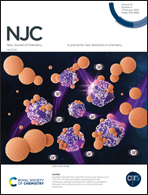Two carbazole disulfonamide-diamide macrocycles with semi-flexible meta-xylyl linkages for anion recognition†
Abstract
Two novel carbazole disulfonamide-diamide macrocycles 1 and 2 with semi-flexible meta-xylyl linkages were designed, synthesized, and assessed for their anion binding properties, via1H NMR and UV-vis titration studies. The single-crystal X-ray diffraction analysis indicated that all five of the NH groups in macrocycle 1 pointed into its inner cavity, with a favorable geometrical conformation for the complexation of anionic guests. The 1H NMR titration results demonstrated that both macrocycles bound strongly and selectively to fluoride ions in DMSO-d6 solution with the affinities in the order of magnitude of 103 M−1 through the formation of 1 : 1 complexes, which was higher than other ten anions tested (including its competitors acetate and dihydrogen phosphate ions). The binding affinities of the two macrocycles were found to follow the order F− ≫ AcO− > PhCOO− > H2PO4− > Cl− > NO2−/N3−/Br−/HSO4−/NO3−/ClO4− (no measurable binding), which was not in accordance with the basicity order of these anions. In particular, macrocycle 1 containing the pyridine-2,6-diamide moiety displayed a preference for F− over AcO− and H2PO4− (having the selectivity factors of 30 and 182, respectively), which was improved by nearly 3-fold after comparison with those for macrocycle 2 bearing the isophthalamide moiety.



 Please wait while we load your content...
Please wait while we load your content...